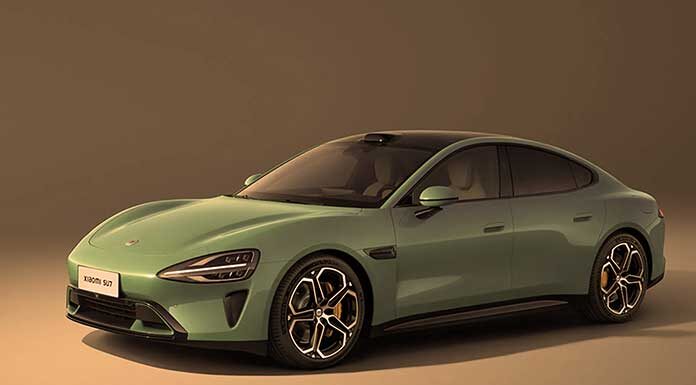Recognized for its plethora of high-tech accessories, the Chinese giant Xiaomi has just launched its first electric car: the SU7. An entirely in-house high-end sedan that seduces with its elegant design and formidable performance, it directly competes with the Tesla Model S. Power, autonomy… What does it really have under the hood to stand up to this iconic electric vehicle?
Xiaomi SU7: Available In Two Versions
A high-tech pioneer, Xiaomi was founded in 2010 and specializes mainly in connected devices. Recognized for the quality, power, and performance of its products, the brand has become one of the largest smartphone resellers in the world and is in third position behind Samsung and Apple. However, it has recently moved towards new possibilities by launching into the production of electric vehicles. It thus presents its new feat: the Xiaomi SU7, a sedan with an elegant appearance and solid performance that wants to compete with the Tesla Model S.
As a result of long years of internal research and development, Xiaomi has lifted the veil on the SU7, its first electric car model. To satisfy more than one person, the manufacturer has designed two versions of this high-end sedan. Suppose the first version promises a power of 300 horsepower with a range of 668 kilometers. In that case, the second, called SU7 Max, provides a power of 673 horsepower and a good range of 800 kilometers—figures that allow it to position itself among the most serious competitors in the high-end electric vehicle segment.
An Electric Sedan Combining Elegant Design And Cutting-Edge Manufacturing
Created by designers from BMW and Mercedes Benz, the Xiaomi SU7 uses all the codes and processes adopted by electric vehicle manufacturers. It thus combines aesthetics and functionality, with a coefficient of 0.195 Cx, designed to promote consumption. As announced by the manufacturer, the alloys used in its manufacture come from its factory. At first glance, the sedan adopts fluid lines with curved fenders and a short hollow hood, similar to the BYD Seal. If the cutout of the front side extractors recalls that of the Porsche Taycan, its front lights with soft angles falsely divided by a light strip are reminiscent of those of the McLaren 750S. As for the rear pillars, they are very inclined, and the stern has a light strip topped with a movable spoiler, which completes the whole thing.
Inside and out, the SU7 packs a punch. It is also as modern as it is surprising, but above all, comfortable and spacious. His forte? Its very refined layout gives way to a small digital dashboard, a 16.1-inch central touch screen, and a high central console equipped with a storage bin and an induction charger for smartphones. Xiaomi plans to continue! Indeed, to go further, the manufacturer is equipping its SU7 electric sedan with a HyperOS operating system modeled on that of the brand’s smartphones for optimized replication of Xiaomi mobile devices. To facilitate control, rocker buttons and an audio volume wheel are present under the screen and on the console.
Added to this is an advanced ADAS automated driving system consisting of Lidar, sensors, and cameras. The tiles of the multimedia system can be moved and resized according to your wishes. Moreover, you have the possibility of installing two touchscreen tablets at the rear. Boarding the Xiaomi SU7 makes each journey an unforgettable experience. What’s more, it offers you optimal driving comfort.
Xiaomi SU7: High Performance And More Than 800 Kilometers Of Autonomy
As stated above, the Xiaomi SU7 is an entirely homemade sedan. The brand itself, therefore, developed the engines. For example, there is the V6 engine, delivering 299 horsepower for 400 Nm of torque and displays a voltage of 400 V, and the V6 engine with a power of 374 horsepower and 500 Nm at 800 V. A third engine, the V8, is planned. During the year 2025, they are offering a power of 578 horsepower and 635 Nm. These figures are enough to hold off competitors against the power of Xiaomi’s electric vehicles.
After having taken a look at the brand’s different engines, let’s get back to the heart of the matter and take a look at the Xiaomi SU7. Although it has already been mentioned previously, the entry-level rear-wheel-drive model has a V6 engine and a 73 kWh CATL lithium-ion battery. As such, it claims 668 kilometers of range according to the Chinese CLTC approval cycle.
Compared to the engine block of the Tesla Model S, which is capable of reaching up to 20,000 revolutions per minute, that of the Xiaomi SU7 can reach 21,000 revolutions.
One point ahead of the American electric car Tesla. One of the strengths of this sedan is that it is capable of going from 0 to 100 km/h in less than three seconds, with a top speed of 210 km/h.
As for the twin-engine SU7 Max with all-wheel drive, it is equipped with V6 and V6s engines supported by a 101 kWh battery with a power of 673 horsepower, 838 Nm of torque, and a range of 800 kilometers, on a single charge, according to to to the Chinese CLTC approval cycle. Just like the entry-level model, the SU7 Max can reach 100 km/h in less than three seconds, but this time, with a top speed of 256 km/h.
If the Xiaomi SU7 has everything to please, whether in terms of design, comfort, power, and autonomy, the manufacturer relies on the Modena 800 V platform to offer charging times faster than ever. In fact, in the space of 15 minutes, the Xiaomi SU7 can recover 510 kilometers of autonomy. A true technological feat!
Also Read: Should You Buy A Foldable Phone?

